Millie, a fatigued mom of an toddler, was prepared for a nap.
So she grabbed her child, flipped it round, threw it on her stomach and began grooming its tail — a soothing habits.

Aggressive and impactful reporting on local weather change, the atmosphere, well being and science.
Millie, a sea otter, is rearing what might be the Aquarium of the Pacific’s first orphaned pup to return to the wild. As a surrogate mother, she’s instructing her adopted child the whole lot she must know to fend for herself — within the hopes she will hack it within the ocean in a couple of months.
“It’s all instinctual, and she or he’s doing it method higher than any human ever can,” mentioned Megan Smylie, sea otter program supervisor on the Lengthy Seashore aquarium.
Their pairing isn’t all about cuddles and rest. Simply earlier than Millie determined it was nap time, the pup often called 968 was training manipulating a crab shell, one of many expertise she’d have to survive within the ocean. She’d additionally have to grasp foraging for meals and grooming her thick, insulating coat.
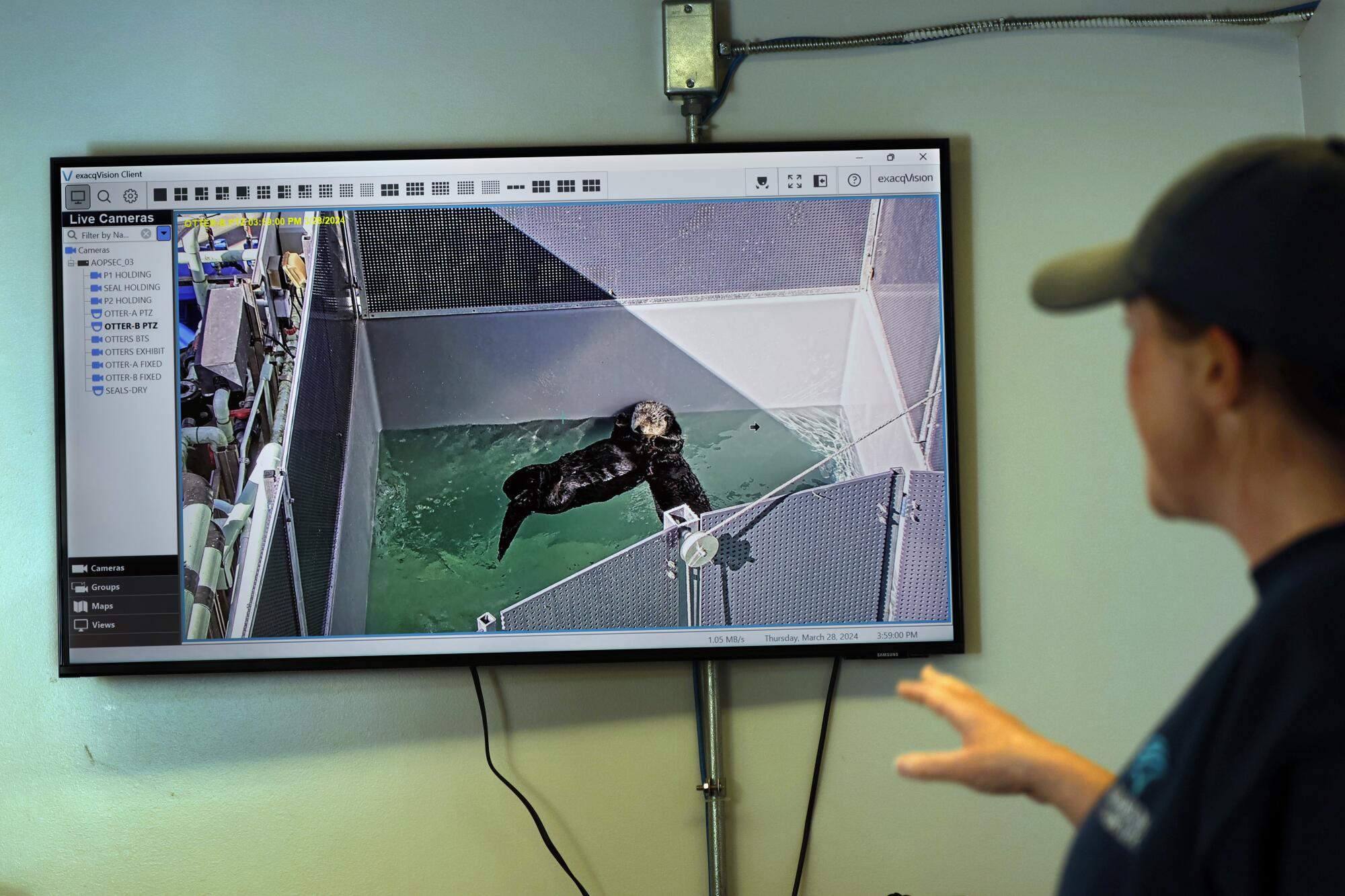
Megan Smylie, sea otter program supervisor on the Aquarium of the Pacific, watches Millie and pup 968 on a display screen. The aquarium is limiting the younger otter’s publicity to people to enhance her possibilities of survival if launched into the wild.
(Allen J. Schaben / Los Angeles Instances)
Local weather warriors in limbo
In contrast to seals and sea lions, otters must be taught fundamental survival expertise. And, conservationists say, their survival is a excessive precedence.
They’re so vital to sustaining a wholesome coastal ecosystem that they’re usually referred to as “local weather warriors.” Otters chow down on urchins, which voraciously devour kelp. When urchins are saved in examine, kelp forests flourish — sequestering carbon and offering meals and shelter for fish, shellfish and different life.
As soon as regarded as extinct, southern sea otters’ rebounding inhabitants has stalled, stymied by shark bites and parasites. They dive, hunt and float from south of San Francisco to simply north of Santa Barbara, a fraction of their historic vary, making them susceptible to localized catastrophes corresponding to oil spills.
There are actually about 3,000 southern sea otters. That’s heartening relative to the overall within the late Nineteen Thirties — about 50 — however a far cry from their 150,000-300,000 peak within the early 18th century. Looking practically eradicated them, whereas protections helped them claw again. The inhabitants has stabilized during the last 5 years.
Generally child sea otters get separated from their moms, who may fall sufferer to a predator or get swept away throughout a storm. In the event that they aren’t reunited or rescued by folks, the outlook isn’t good; most child otters can’t survive lengthy alone.
With the current rollout of its otter surrogacy program, the Aquarium of the Pacific joined the Monterey Bay Aquarium’s efforts and has roughly doubled the capability in California to rehabilitate orphan otters utilizing adoptive mothers — a technique analysis has proven offers the otters the perfect likelihood (about 75%) of being wild once more.
It’s a promising enlargement, however nonetheless falls in need of the necessity. Most years, extra otters strand than the Lengthy Seashore and Monterey amenities can accommodate, based on staffers.
“So rising this program goes to be a fairly excessive precedence for those who are invested in otter conservation,” Smylie mentioned.
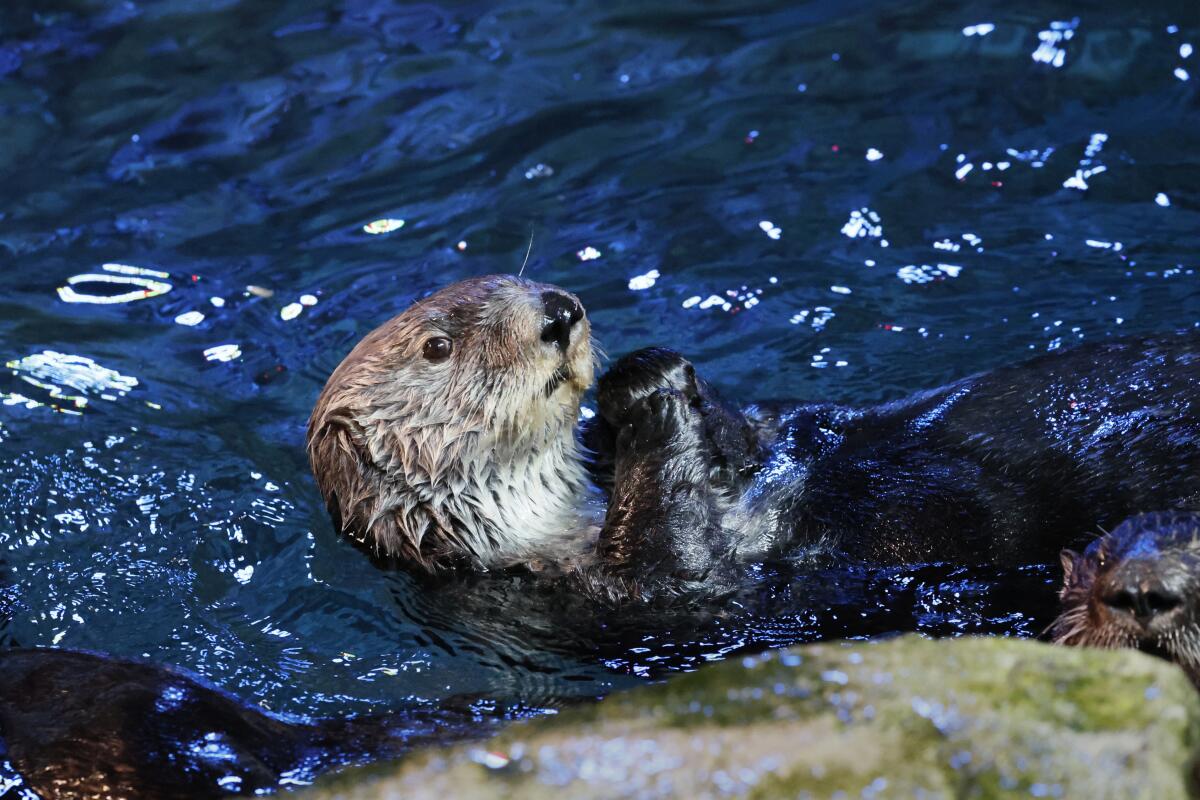
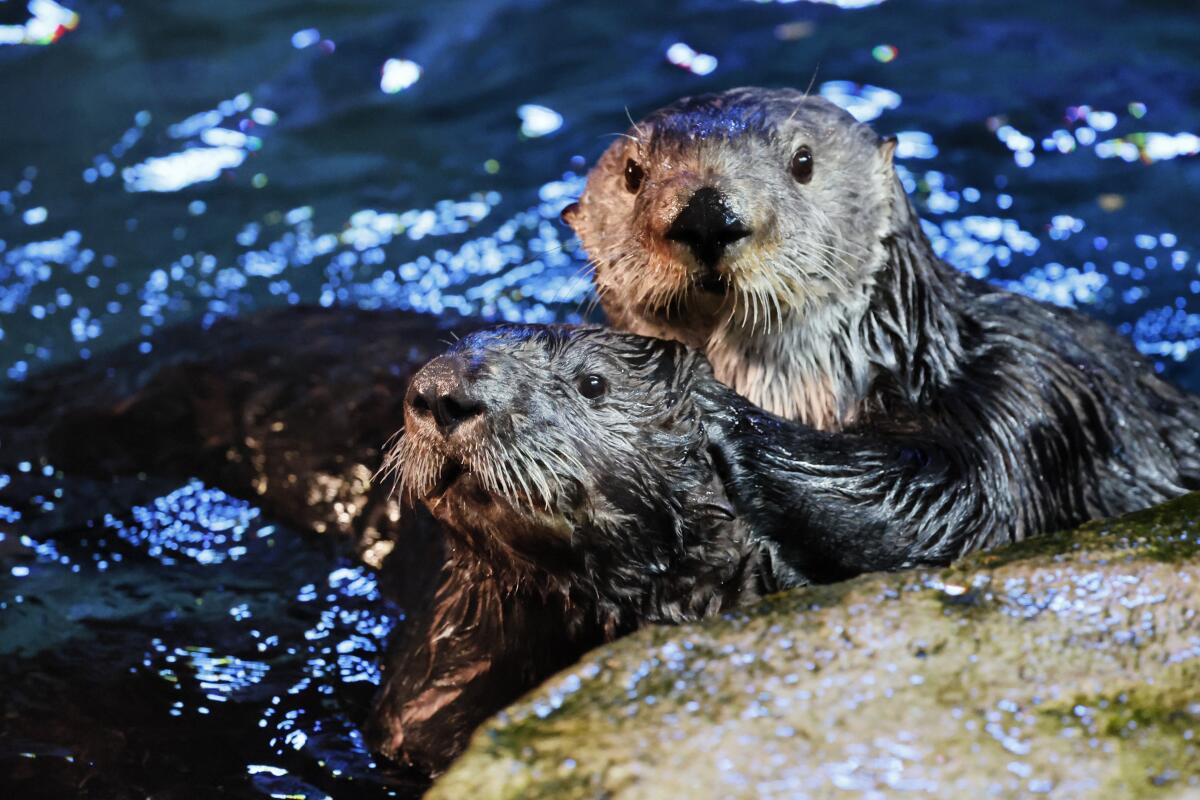
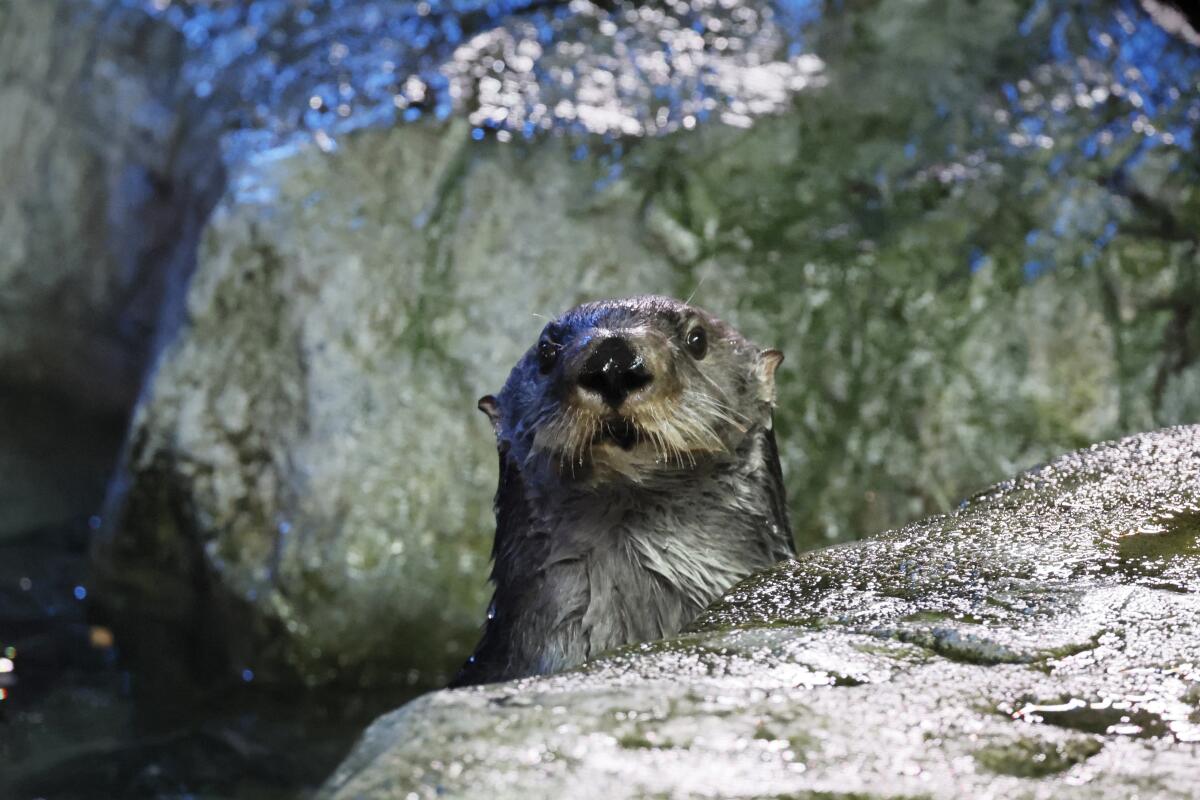
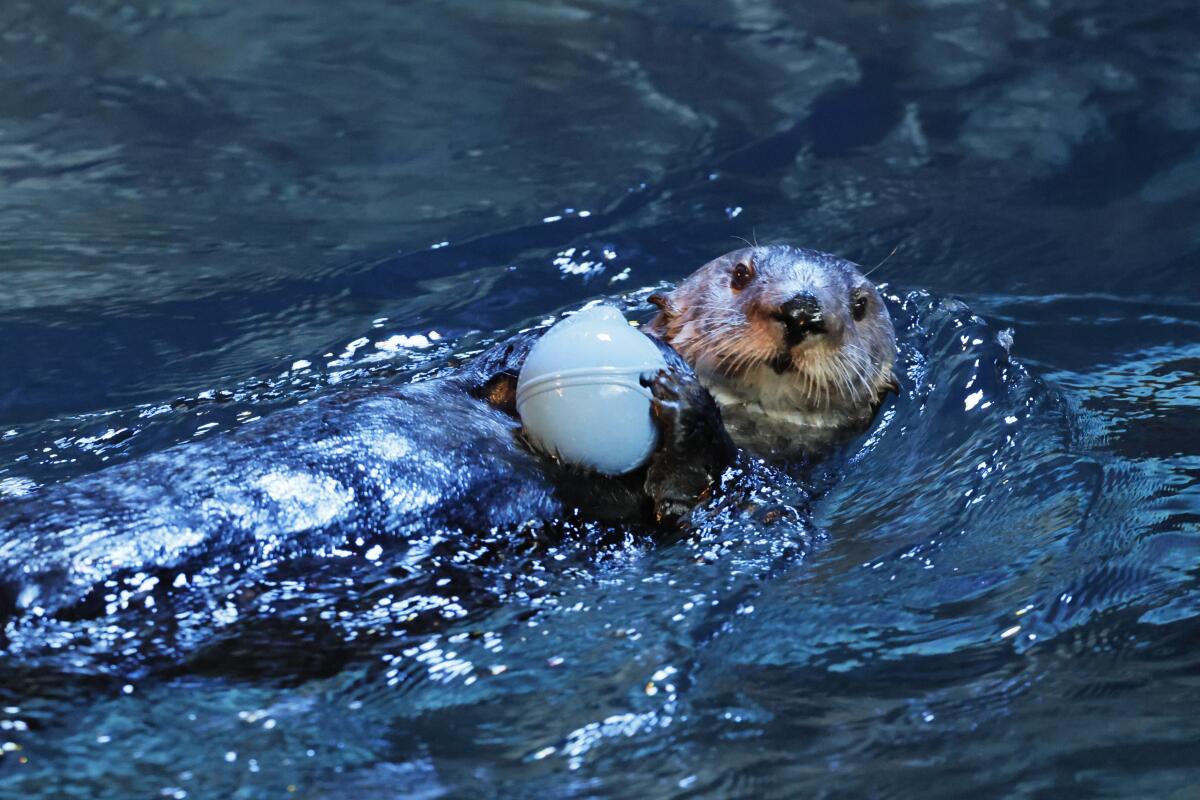
The otters the general public can see on the Aquarium of the Pacific present loads of cuteness. (Allen J. Schaben / Los Angeles Instances)
Howdy 968
Towards the top of January, a passerby discovered 968 stranded north of Santa Cruz. Generally an otter mother will be heard calling out for her child someplace close by. However the pup was on their lonesome.
She was about 8 weeks outdated, and nonetheless depending on her mom for survival. (Otter dads should not within the image.)
So she was taken to the Monterey Bay Aquarium, the place all sea otter pups stranded in California move via. Her quantity denotes that she’s the 968th otter to enter the aquarium’s rehabilitation program.
Pups aren’t simply tossed again into the surf; they have to undergo rehabilitation to discover ways to be an otter.
So started her lengthy, and nonetheless unsure, path again to the chilly coastal waters of Central California.
Instructing an otter the best way to be an otter
The Aquarium of the Pacific’s foray into otter surrogacy is an outgrowth of the pioneering efforts of the Monterey Bay Aquarium, which began rescuing otter pups within the mid-Eighties, even earlier than it formally opened its doorways.
The surrogacy idea emerged early on, mentioned Jessica Fujii, supervisor of the Monterey Bay Aquarium’s sea otter program. Within the wild, via their analysis program, workers “noticed adoptions occurring naturally; it wasn’t frequent, nevertheless it had been seen,” she mentioned. “So there was this thought that the robust maternal instincts that sea otters have may translate to the surrogacy in care.”
However an early try, in 1987, wasn’t profitable. So for a time staffers tried to behave because the pup’s mother, even swimming and diving alongside it in a giant tidepool close to the aquarium to show it to forage.

To maintain rehabilitating otters from turning into too snug with people, aquarium workers members corresponding to Brett Lengthy watch them remotely.
(Allen J. Schaben / Los Angeles Instances)
Whereas otters raised this manner had been capable of hunt, they didn’t all the time socialize correctly, mentioned Brett Lengthy, senior director of birds and mammals at Aquarium of the Pacific. Many had been too snug with folks.
“We’re superb at maintaining them alive and superb at maintaining them wholesome,” Lengthy mentioned. “What we’re not superb at is instructing them the best way to be an otter again on the market.”
Then, in 2001, the Monterey Bay Aquarium paired an orphaned pup with Toola, a stranded feminine otter who’d had a stillborn. The pair bonded.
From there, the aquarium tried pairing orphans with otters that hadn’t been “primed” by a current beginning. Extra success.
They continued refining the strategies, distancing people from the caretaking course of as a lot as doable. Caretakers put on disguises harking back to Darth Vader’s getup throughout feedings — in order that they’re not acknowledged as folks. Panels are put round their swimming pools to dam the sight of people, and the otters are monitored remotely. Releasable otters are additionally by no means positioned in aquarium shows the place throngs of tourists can “ooh” and “ahh” at them.
Researchers beforehand thought “expertise and data of the ocean was a very powerful half” of the rearing course of, Fujii defined. “And what we since discovered is that actually that social facet and that sort of identification as, ‘You’re an otter,’ was actually key.”
Over twenty years, 70 pups have handed via the Monterey aquarium’s surrogacy program. Ten mature feminine otters did their half as adoptive mothers. A research discovered the rewilded otters contributed to inhabitants development in an estuary referred to as Elkhorn Slough. In 2002, when the aquarium started its releases, there have been solely about 20 otters within the estuary. By 2016, there have been greater than 100.
In late February 2020, the Lengthy Seashore aquarium introduced it was becoming a member of the surrogacy program as a accomplice and welcoming Millie, who’s now 7. The pandemic across the nook delayed this system’s rollout, and it wasn’t till September 2023 that the allow was authorised. However they nonetheless needed to look ahead to a stranded otter to place Millie’s surrogacy expertise to the check.
A protracted highway residence
After a three-week stabilization interval, 968 was pushed from Monterey to Lengthy Seashore. Through the roughly six-hour drive, she had ice to munch on and funky air piped in.
When 968 met Millie in February, it wasn’t familial love at first sight — no less than on the pup’s finish.
She stranded later than most pups, which means she could have had some reminiscence of her organic mother, consultants mentioned.
“And so the primary time it met Millie, it was like, ‘You’re not my mother.’ And Millie, luckily, was simply affected person and was, like, ‘Hey, I’m within the pool. I’m hanging out,’” Lengthy mentioned.
A really chill stepmom tactic.
However by the sixth day, issues had been much less chill. If a bond doesn’t kind in seven days, then it seemingly by no means will, Lengthy mentioned.
Aquarium personnel would get excited each time the pup swam nearer to Millie. When the 2 otters lastly united, after practically seven days, cheers erupted from the workplace the place they watched the occasions unfold on a livestream.

Millie and 968, seen on a TV display screen on the Lengthy Seashore aquarium, are actually inseparable.
(Allen J. Schaben / Los Angeles Instances)
“I don’t know that that’s going to fade,” Lengthy mentioned of the collective enthusiasm. “There’s some invested folks on this mission, [and] this has turn into a very fashionable nook of our administration.”
Now Millie and the pup are inseparable. In late March, 968 rested on Millie’s stomach the perfect she may — the pup had grown to round 18 kilos, from about 11 when she arrived in Lengthy Seashore.
After a calming nap within the solar, they made their strategy to the opposite aspect of the pool. The pup, now about 4½ months outdated, performed with a chunk of a crab shell as Millie relaxed on a platform. Quickly the hyper child scampered up subsequent to mother in what gave the impression to be the otter model of “Ma, take a look at me!” In accordance with Lengthy, the pup was in a stage akin to the horrible twos.
Millie, in a way, is giving again to this system. She was raised via surrogacy herself and for some time did simply wonderful within the wild — till folks began feeding her, which is against the law, consultants mentioned.
When she was about 2½ years outdated, she began leaping on kayaks, and federal wildlife officers ordered her out of the water. When Millie was fished out, it turned out she was pregnant. (Millie’s story is harking back to the surfboard-stealing otter that grew to become a nationwide sensation over the summer season. That otter, dubbed 841, gave beginning within the wild shortly after her antics grabbed headlines.)
Millie raised her pup utilizing the surrogacy program protocols, and it was finally launched. It seems her maternal intuition hasn’t light.
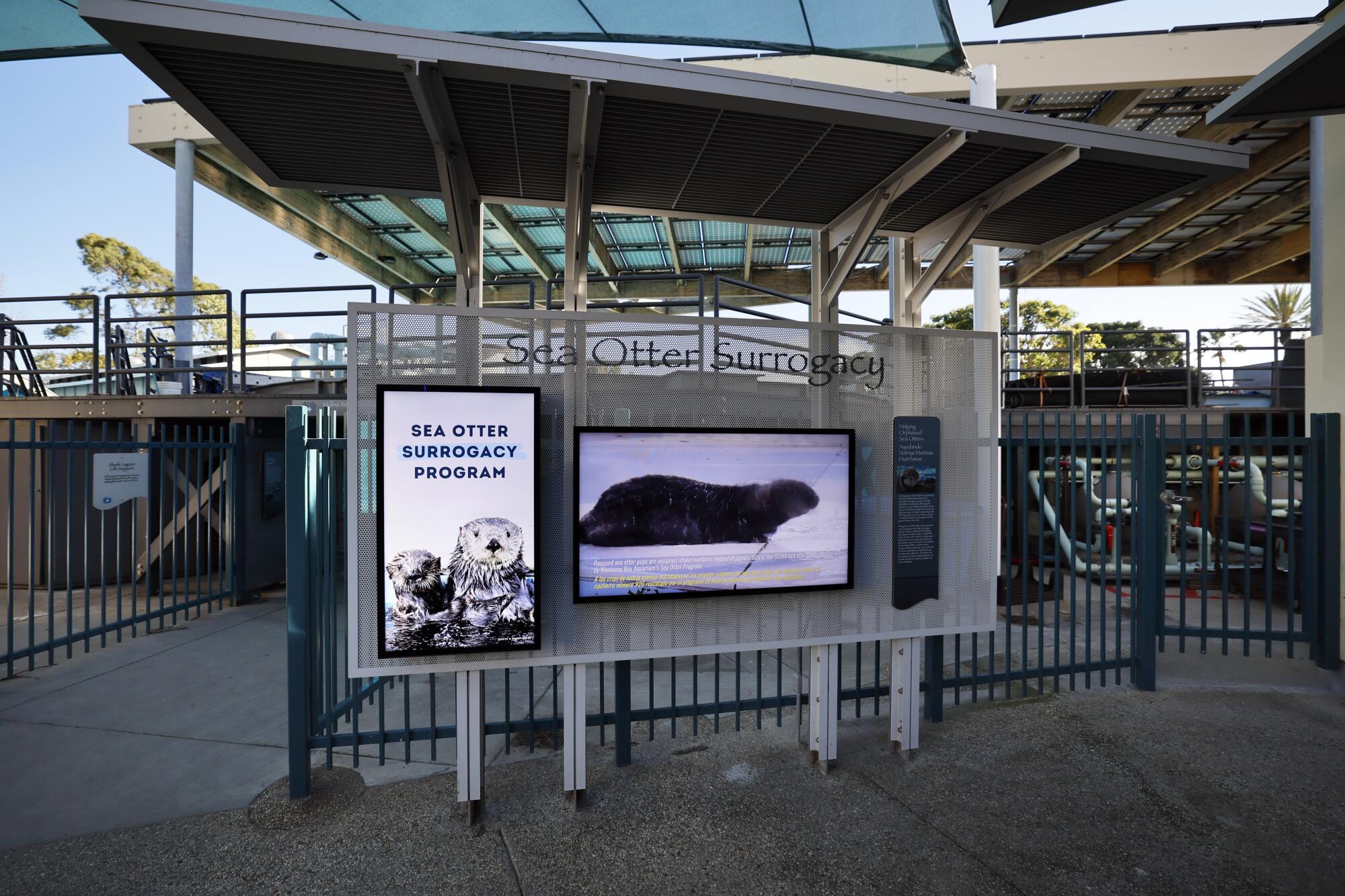
The ocean otter surrogacy program exhibit on the Aquarium of the Pacific in Lengthy Seashore doesn’t have a stay video feed of Millie and 968, nevertheless it does have cute child otter footage.
(Allen J. Schaben / Los Angeles Instances)
The check
The launch of 968 will depend upon whether or not she will attain sure developmental milestones. She has to point out she will look after her luxurious fur; crack open clams, mussels and different meals; socialize fairly nicely with different otters and keep away from people.
She’ll separate from Millie when she’s about 6 months outdated — the age pups usually go away “residence” — and head again to the Monterey aquarium the place she’ll hang around with otters nearer to her personal age. There, she’ll additionally get the chance to hunt stay prey.
If all goes nicely and she or he passes a ultimate well being examination, she’ll return to her native waters. She’ll be implanted with a tracker and rigorously monitored for 2 weeks. After that interval, her survival chances are high pretty much as good as any otter.
Sadly, you possibly can’t wave to 968.
As a result of the surrogacy program hinges on maintaining people away, guests on the Lengthy Seashore and Monterey aquariums received’t be capable to see the otters. The rearing swimming pools on the Aquarium of the Pacific are tucked behind a medical middle and a marine mammal safety regulation prohibits livestreaming their actions to the general public.
Nevertheless, the Lengthy Seashore aquarium has launched an exhibit explaining this system. And, sure, it does embrace lovable video of child otters.
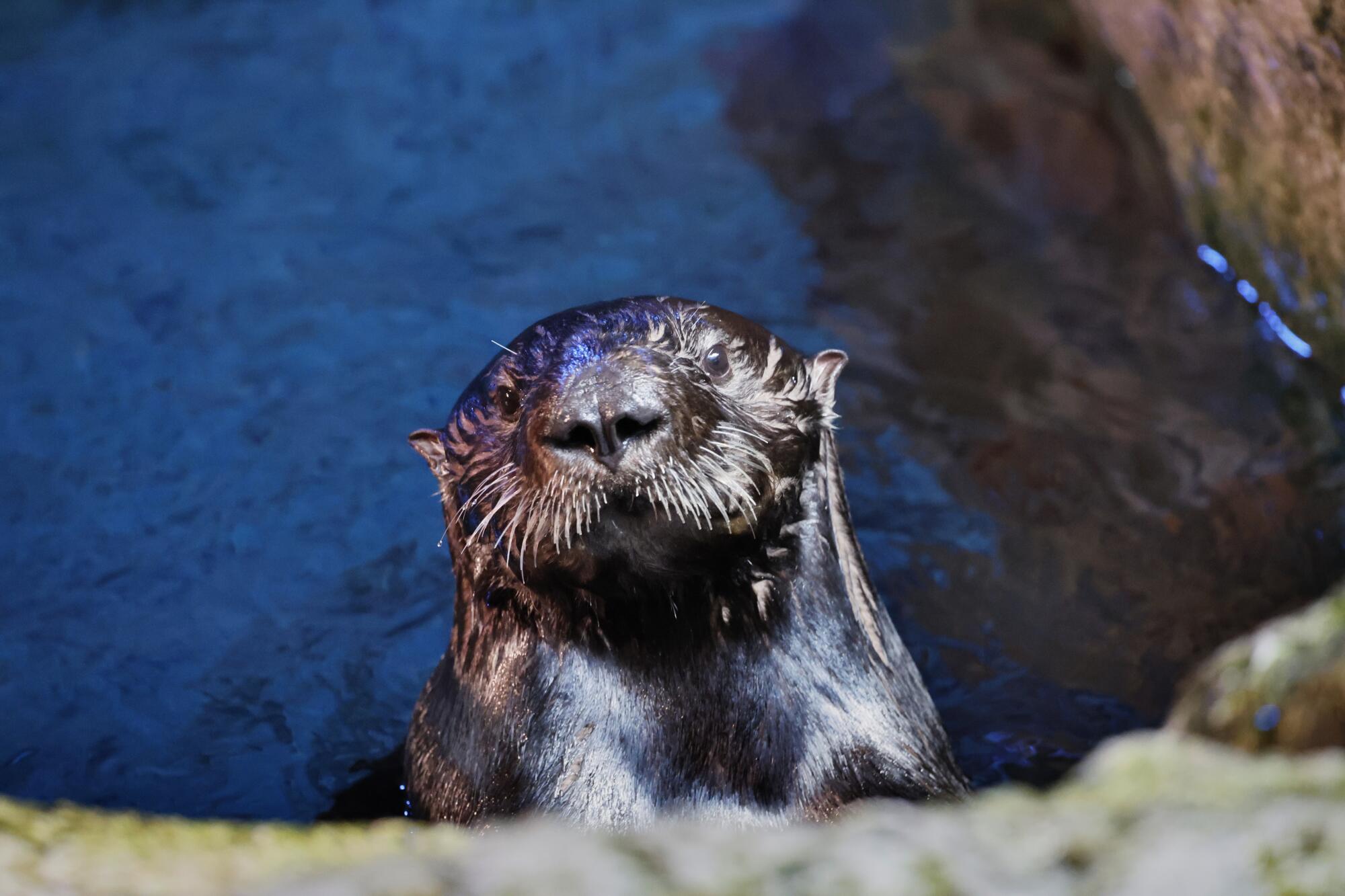
(Allen J. Schaben / Los Angeles Instances)
